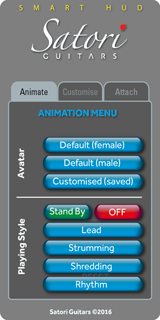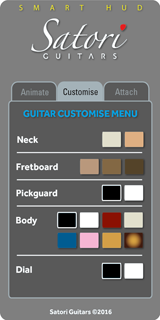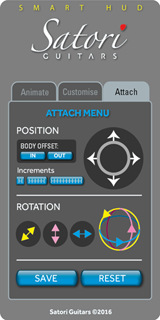- DESIGN
- MESH
- ANIMATION
- SCRIPTED SYSTEMS
Everything starts with design
Guitar makers combine functionality with great design. Anyone who plays a quality guitar (or anyone who builds one) quickly comes to appreciate the considerable artistry that has gone into its making. Musicians dedicate big chunks of their lives to their instruments, they form intimate relationships with them. What you play on matters in the same way that what you play matters.
Virtual Realities have linked musicians to international audiences in ways that would not have been considered possible two decades ago—thanks to shoutcasting and other web broadcast systems, and thanks also to the popularity of live performances on virtual platforms like High Fidelity, SecondLife and OpenSim grids. But those performances often result in a small disconnect for "live" audiences. Avatar physics haven't improved much in the last decade. In SecondLife, an avatar cannot move her fingers or toes. Her lips don't move when she sings or speaks. Add to this that the accepted standards of animation are very low in the popular grids, even among those employing mocap technology, and much of this is due to a lack of realistic collision physics where the hands of a guitarist pass too easily through the neck of the guitar. Even the best animators can do little to accommodate the vast range in avatar body shapes and sizes or the eccentricities of proscribed limits to motion arcs. An avatar with the physique of a gorilla moves very differently on an animation to a "ruth" avatar.
But a lot of quality issues start with laziness and a "good enough" mentality from designers, builders and animators, who harness 'suspension of disbelief' as a cover for the deficiencies of their work.
We know that there are limits to how many faces you can load on a prim and that some animations will always be compromised by avatar shape, motion arcs and collision physics, but we are determined to take our designs right to the edge of those fidelity limits. It matters to a guitarist that (s)he is playing a Les Paul or a Strat and that they actually look like they're playing. It matters what that guitar looks like, that it's an accurate facsimile and not a photograph painted on a flat block. It matters that there is logic in the stage set up (cables going to amps, etc). Our aim is to take the musician's experience and the audience experience as far as it can go towards realism. That dedication to a quality principle is what makes Satori unique.
Blender at the limit
Blender lets builders do a lot more than simply distort prims into mesh objects. It allows 3D modellers to fabricate complex objects into a single prim that would otherwise require hundreds of prims using "inworld" building tools. It also allows complex moulding, cutting, smoothing and texturing of objects beyond anything possible with standard prim building.
Although Blender is a common tool among Secondlife builders, its immense power to model is only tapped into lightly. Complex mesh prims are considerably more expensive (in Linden currency) to upload than standard prims and there is no "builder's leeway" supplied by Linden Labs to allow testing prior to finalimporting—an oversight which is undoubtedly lucrative for Linden Labs but short-sighted: it strongly discourages quality mesh content. Linden Lab's habit of charging exhorbitant rates for "land impact" adds to this problem. To properly understand how a mesh model will render, you have to render it. You have to experiment with upload settings to determine the optimal LOD (Level of Detail) for that object (almost never default SL settings). You have to test for glitches and overflows in textures, and for broken surfaces and reversed normals. This feedback process is even more vital with really complex shapes where loading — tweaking — loading... is the only way to finesse your build. Our luthiers tell us that as many as a hundred uploads can be required to perfect a single instrument. Yet for cost reasons, many builders avoid doing anything like this, or else avoid creating the sort of detail in their modelling that requires scrutiny.
Satori maintains a test grid for its builders modelled on the physics of SecondLife. Every piece is perfected there prior to being shipped to SecondLife. Thanks to this, Satori are able to exploit the full potential of mesh modelling and create work that defies common limitations.
SAS—the Satori edge
A significant limitation with animations is that they run on looped cycles. Repeating is not so bad in music—musicians almost always play patterns. But they don't play them with idiocyncratic accuracy, and sometimes they break out and solo or transition their song or piece. SecondLife and OpenSim place a 30 second duration limit on animation imports. That means an animation HAS to repeat inside a 30 second period to play in continuous fashion. When you build an animation with a distinctive move, its loop interval becomes very obvious.
To avoid this 'repeat' glitch, Satori animators have devised a Stochastic Animation System. Rather than limiting ourselves to a 30 second animation window, we deploy a series of ten or more 6–12 second animations for every loaded playing style. These modules have seamless edges, meaning that any block of animation can flow into the next block without a viewer detecting the transition. This means that the blocks can be organised or even randomised to minimise repeats, and that distinctive "break out" moves can be scheduled for rare repeats or none at all. The result is a very lifelike stage performance with no detectable global repeat patterns. It also means that we can repeat the musician's hand movements while changing pose and expression, as real musicians do, to enhance realism.
Satori's SAS (Stochastic Animation System) is deployed in animations for all our instruments and microphones.
Innovative HUD design
The HUD (Heads Up Display) supplied with each Satori instrument is custom built for that instrument. A typical HUD has three or more tabs that provide the musician with an Animation Menu (for selecting playing style); a Customise Menu—to personalise the instrument by changing colours and textures on different parts of the instrument; an Adjust Menu—to make fine adjustments to the position of the instrument on your avatar for maximum animation fidelity. Custom settings are saved so that you can restore them with a click. Our HUDs are intuitive, powerful, elegant, and unobtrusive, giving you complete control over your playing.




